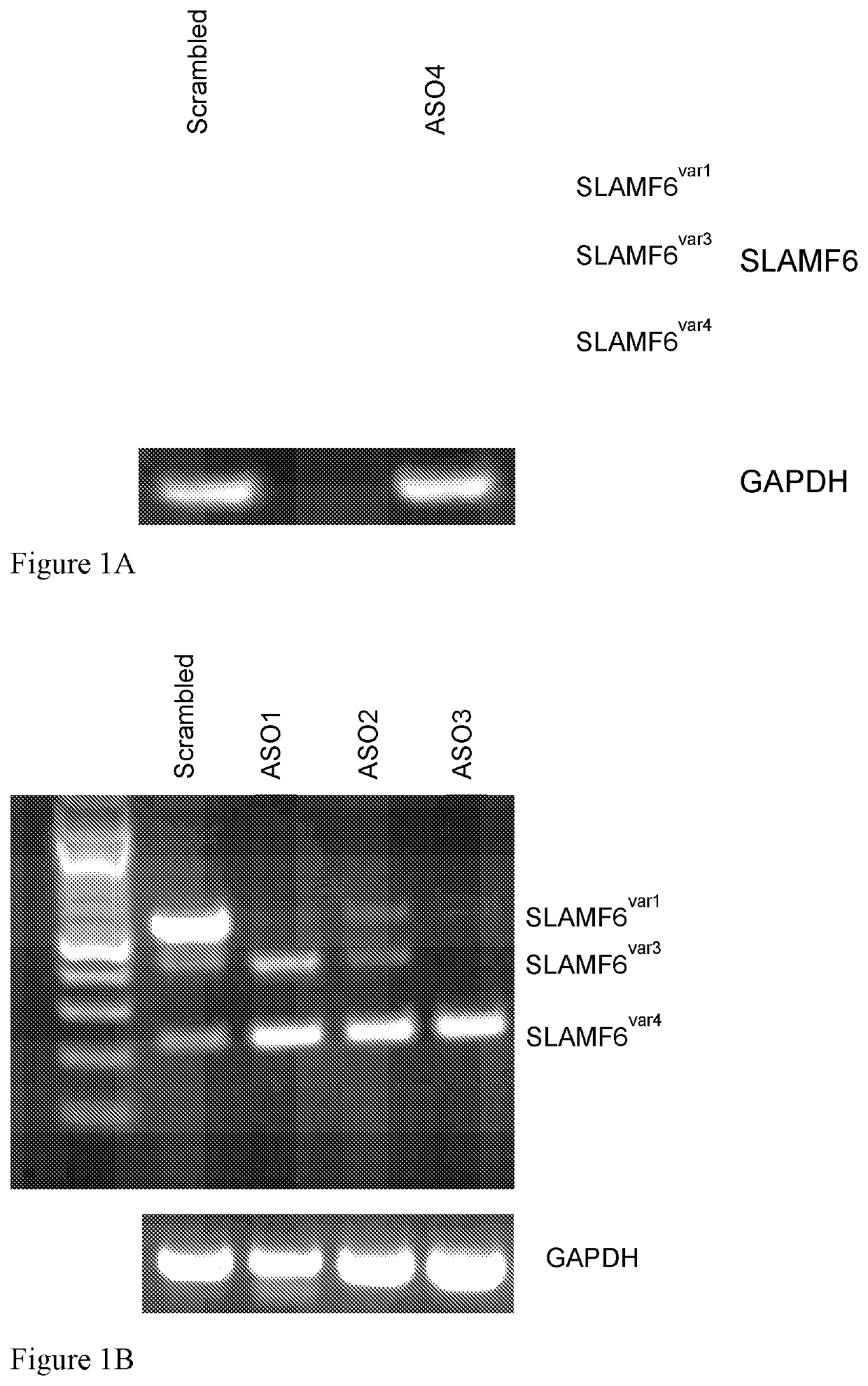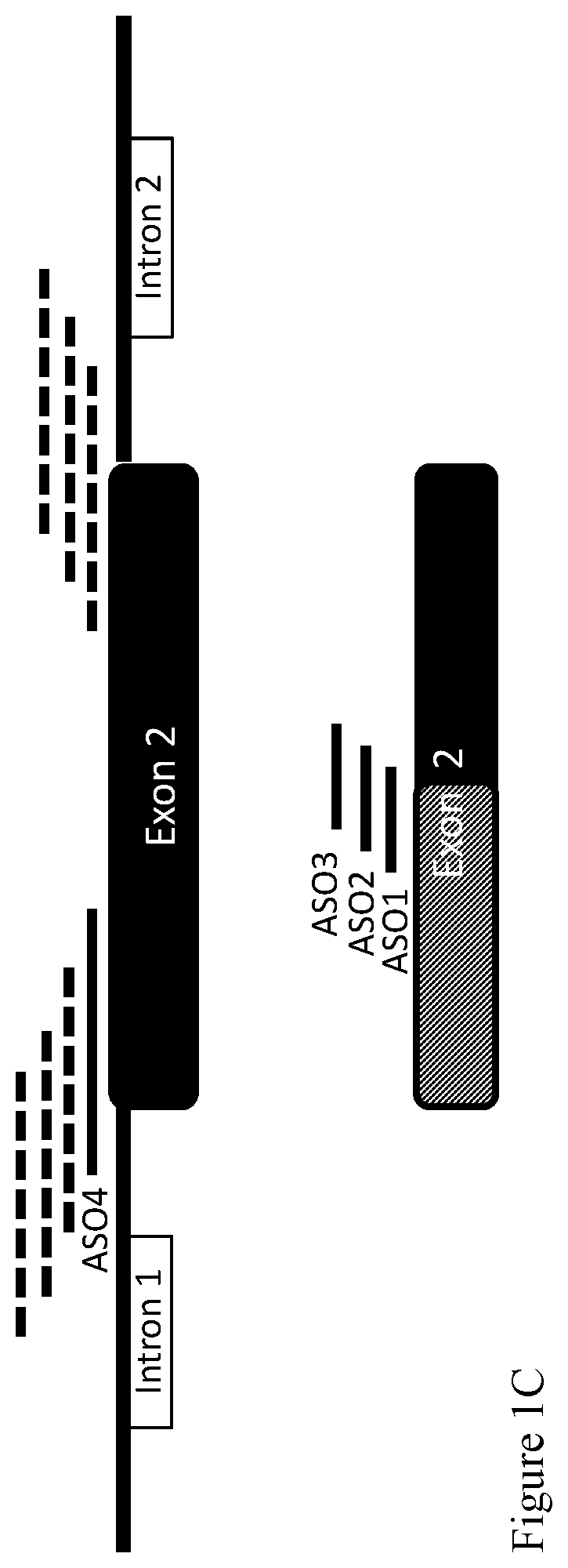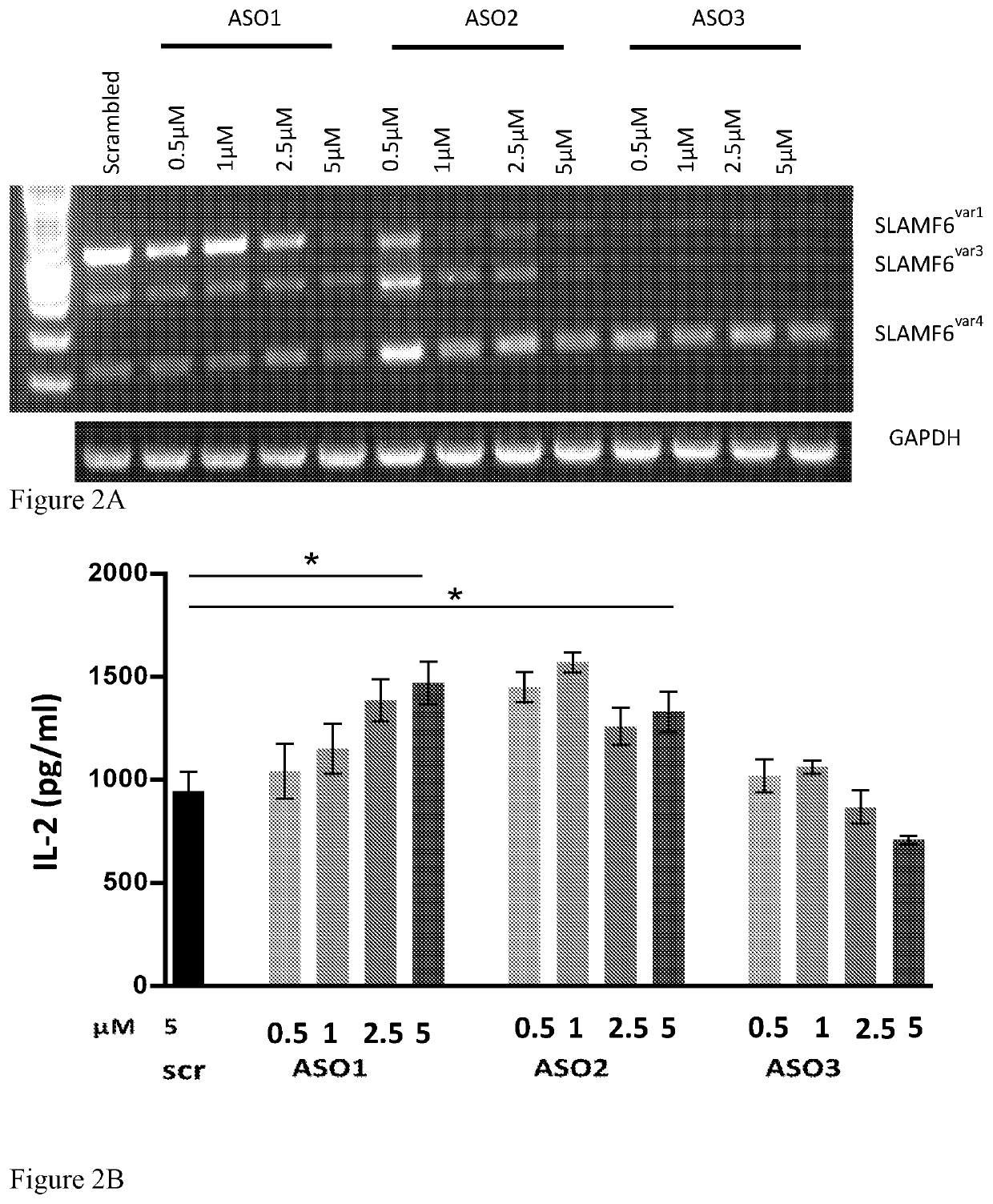Nucleic acid agents modulating slamf6 isoforms
a technology of slamf6 and nucleic acid, which is applied in the direction of antibody medical ingredients, peptide/protein ingredients, drug compositions, etc., can solve the problems of identifying splice-regulating elements and regions, and designing oligonucleotides with sufficient efficacy in inducing splice switching that may be used therapeutically, and remain challenging
- Summary
- Abstract
- Description
- Claims
- Application Information
AI Technical Summary
Benefits of technology
Problems solved by technology
Method used
Image
Examples
example 1
cted to Previously Suggested Regulatory Regions
[0178]20-mer ASOs, designed to target various regions at the intron-exon junctions either upstream or downstream to exon 2 (Hajaj et al., 2018), were synthesized using 2-O-Me modified nucleosides. The ASOs were transfected to Jurkat T cells (5×106 cells in 3301 RPMI medium, 5 μM of the ASO) by electroporation in Biorad 0.2 cm cuvettes using ECM 630 Electro Cell manipulator (BTX Harvard apparatus) Exponential electroporation—250V, 300 μF, 1000Ω. 24 hours later, RNA was extracted using GenElute Mammalian Total RNA kit (Sigma, RTN70) according to the manufacturer's protocol. SLAMF6 isoforms were detected by RT-PCR using primers directed to exons 1 and 3, as follows: GCGGAAAGCATGTTGTGGCTG (SEQ ID NO: 11) and GGAGACAGTGAGGTTTGGCTG (SEQ ID NO: 12), respectively.
[0179]A representative ASO, herein designated ASO4, has the nucleic acid sequence UUGUGAAACUACAUUCCCUG (SEQ ID NO: 9) and specifically hybridizes with a target sequence at the intron 1...
example 2
ation of a New Target Region for Modulating SLAMF6 Splicing
[0181]Additional ASOs, with sequences designed to bind various target sequences within exon 2, were also examined in similar experiments. The positions of these partially overlapping ASOs are schematically represented at FIG. 1C, bottom (in which the right side, presented in black, represents the portion of exon 2 present in both variants, and the left, light-shaded side, represents the portion of exon 2 present only in SLAMF6var1. The sequences of the ASOs, designated ASO1, ASO2 and ASO3, are GGGUACUAUGAAGGCAAGAG, UCAUGGGGUACUAUGAAGGC and UGGUUUCAUGGGGUACUAUG (SEQ ID NOs: 1-3, respectively). The target sequences specifically hybridizable with these ASOs are as set forth in SEQ ID NOs: 6-8, respectively (CTCTTGCCTTCATAGTACCC, GCCTTCATAGTACCCCATGA and CATAGTACCCCATGAAACCA). The ASOs were also synthesized using 2-O-Me modified nucleosides and used in the same concentrations as described in Example 1. The results are presented ...
example 3
n the Expression Ratio of SLAMF6 Splice Products Following Treatment with Splice-Switching ASOs is Correlated with an Improved Functional Capacity
[0183]For evaluating the effects of the ASOs on T cell function, four increasing concentrations (0.5, 1, 2.5 and 5 μM) of each of ASO1, ASO2, ASO3 or the control ASO (scrambled, scr; 5 μM) were transfected to Jurkat cells (5×106 cells in 330 μl RPMI medium) by electroporation as described in Example 1. 24 hours later, the cells were collected and activated with a combination of PMA (200 ng / ml) and Ionomycin (300 ng / ml) for 48 hours. Next, the conditioned media were collected and IL-2 secretion was evaluated using ELISA (DY202 Kit, Human IL-2 DuoSet ELISA (R&D)). The results are presented in FIG. 2A (effect on SLAMF6 isoform transcript levels) and FIG. 2B (IL-2 secretion).
[0184]As can be seen in FIGS. 2A-2B, two out of the three ASOs, namely ASO1 and ASO2, significantly enhanced IL-2 secretion induced by activation stimuli. However, ASO3 di...
PUM
 Login to View More
Login to View More Abstract
Description
Claims
Application Information
 Login to View More
Login to View More - R&D
- Intellectual Property
- Life Sciences
- Materials
- Tech Scout
- Unparalleled Data Quality
- Higher Quality Content
- 60% Fewer Hallucinations
Browse by: Latest US Patents, China's latest patents, Technical Efficacy Thesaurus, Application Domain, Technology Topic, Popular Technical Reports.
© 2025 PatSnap. All rights reserved.Legal|Privacy policy|Modern Slavery Act Transparency Statement|Sitemap|About US| Contact US: help@patsnap.com



